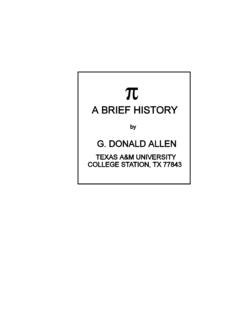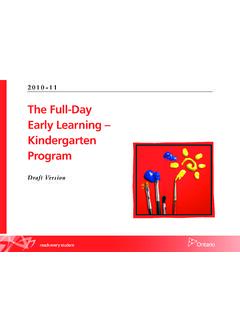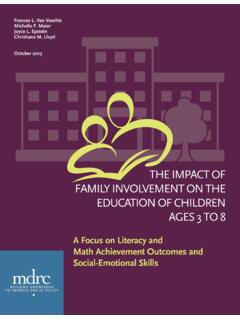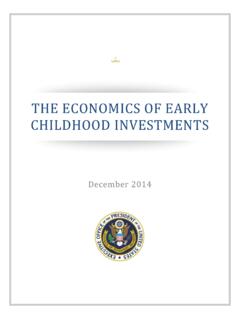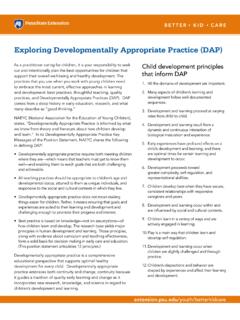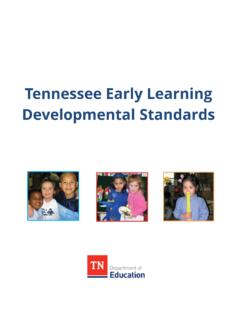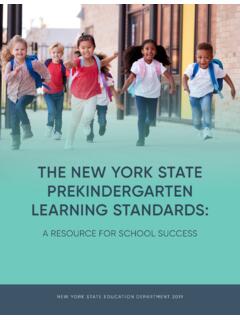Transcription of Developing Math Skills in Early Childhood - ed
1 1 Infants begin to learn math before they can sit up. They notice differences in quantity, they compare the shape and size of objects, and they use Early math concepts when they play and in other aspects of their daily math helps children to develop the ability to think critically and solve ,3 Both are integral to success in school and in life, but not all children learn the math Skills they need to Barbara Harris and Dana PetersenDeveloping math Skills in Early ChildhoodAUGUST 2017 EDUCATIONPRINCETON, NJ - ANN ARBOR, MI - CAMBRIDGE, MA - CHICAGO, IL - OAKLAND, CA - TUCSON, AZ WASHINGTON, DC - WOODLAWN, MDWHY IS Early math IMPORTANT?
2 A large body of evidence shows a connection between being competent in Early math and success in school, even after controlling for family characteristics, Early IQ, reading achievement, and other In fact, Early math Skills may be the strongest predictor of later success in both reading and , 9, 11-12 Weaknesses in math Skills , however, begin Early and are evident by the time children enter Unfortunately, children who enter kindergarten with weak math Skills are likely to remain behind their peers in the later , 12, 14 In addition, the children who are the least prepared in math when they enter kindergarten tend to be from minority and low-income families, or they are just learning to speak , 15 These factors suggest that improving the long-term outcomes for all children may depend on exposing them to more Early math concepts before they enter school.
3 STATE FACTS16 Only 66% of children are ready for kinder-garten math . Only 46% of children from low-income fami-lies and 43% of Hispanic children are ready for kindergarten math . This brief presents a promising approach to supporting the development of Early math Skills in young children. The approach synthesizes the influence of parents, the home environment, and children s health care providers, and is being implemented in Washington State by Reach Out and Read. Reach Out and Read is a program in which health care providers give young children new books while modeling effective reading techniques and encouraging parents to read with their children at home.
4 When families participate in Reach Out and Read, parents read aloud more often and children improve their language and literacy Because math and reading can be integrated through Reach Out and Read, parents can learn to simultaneously support the development of their children s Early language, literacy, and math Skills in an enjoyable and developmentally-appropriate way. Thus, the program has the potential to improve kindergarten readiness in math and literacy. Because children see their health care providers often during the first few years of life, Reach Out and Read s initiative could support a large percentage of children through the network of Reach Out and Read programs in Washington State and across the nation.
5 2 WHAT IS Early math ? The term Early math refers to a broad range of basic concepts such as counting (1, 2, 3); quantity (more, fewer); shapes (circles, squares, triangles); spatial relations (over, under); measurement (tall, short; bigger, smaller); and patterns (red, blue, red, blue).18-19 Because children are naturally curious, they explore these concepts as they interact with their For example, young children explore math when they play and build towers with blocks. In building, they sort the blocks by size and color, notice spatial relationships, and develop reasoning Skills as they learn which shapes can be placed on top of one another, which ones will topple the tower they have built, and how to combine shapes to create familiar Preschoolers count or compare objects as they play, and explore patterns and shapes.
6 21 Children must interact with adults, however, to learn the words that represent the basic math concepts that they experience. Parents and other adults can incorporate this developmental support into their daily routine. For example, while building towers or reading books with young children, parents can point out and use words to denote different sizes and shapes. For toddlers and older children, parents and adults can use regular activities, such as doing laundry, as a teaching tool by encouraging children to count or sort items in a laundry basket. Setting the table for a meal is another way to encourage children to think in mathematical terms.
7 Parents or adults could ask a child how many spoons are needed on the dinner table. Figure 1 shows the progression of some of the typical math concepts that children learn from birth through age must interact with adults to learn the words that represent the basic math concepts that they of Early math Skills over time Figure 1 HOW IS THE DEVELOPMENT OF Early math RELATED TO Early LITERACY? A common concern is that supporting Early math might mean taking time away from something else, such as Early literacy. Yet, this does not have to be the case. The development of Early math and Early literacy Skills are intertwined,3 and efforts to support both can take place simultaneously.
8 In fact, when math is taught hand-in-hand with other subjects, such as reading, children learn more math than they would if they were taught only Children learn math and language in a similar progression. Starting in infancy, language and literacy Skills develop over time as children build their vocabulary, sentence length, and sentence complexity. Children learn how to express their ideas in words by building their vocabulary, their understanding of grammar, and their ability to use longer, more complex Learning Early math involves a similar progression as children initially learn basic math vocabulary, then how to recognize math in the world around them, and then over time learn how to express more complex math concepts involving measurement, geometry, and , 23 Distinguish between small groups of objects (1 versus 2)Use number words to label small quantites (such as 1 dog or 2 cats)
9 Count objects by touching or pointing to themQuickly recognize small groups of objects without counting (such as 1, 2, or 3 balls)Begin to add or subtract small quantities (such as adding or subtracting 1 or 2 toys)InfantsToddlers2-3 years old3-4 years old4-5 years old Babies are born learning, and parents are the most powerful force shaping Early brain development. Nurturing, responsive relationships at home from the earliest days of life provide the foundation for learning across all domains, including social-emotional, language, literacy, and math . --Jill Sells, MD, Seattle, Washington3 Reading books, telling stories, and using math talk are easy, effective ways to integrate and promote the development of Early math and Early literacy Skills .
10 Children s books provide many ways to highlight math . For example, Moo Baa La, La, La by Sandra Boynton enables counting of animals on each page and comparisons of relative size (big and small animals). Goodnight Moon by Margaret Wise Brown provides opportunities to count items on each page and learn about spatial relations such as over and under. The Doorbell Rang by Pat Hutchins shows how sharing a plate of cookies can be used to introduce fundamentals of fractions and division. These are just three examples of children s books that simultaneously support the development of Early math and literacy CAN PARENTS AND THE HOME ENVIRONMENT SUPPORT CHILDREN S Early math DEVELOPMENT AND SUBSEQUENT LEARNING?










